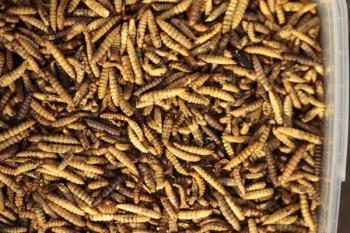
New study confirms benefits of nutritional management for atopic dogs (Sponsored by Iams)
The article breaks down the method and results of a double-blind study that compares the performance of three commercial veterinary diets during in-home management of clinical signs in atopic dogs. Also included Case study Cindy
Canine atopy is a multifactorial disease in which genetically predisposed dogs develop a combination of cutaneous immune responses to environmental antigens. Although the clinical signs can often be controlled, managing atopic dogs can be frustrating. Dogs usually require life-long therapy, and in most cases, a multimodal treatment plan is needed to yield optimal results.
Nutritional management is a simple but powerful tool in controlling pruritus in dogs with allergic conditions.1-3* In atopic dogs, feeding a diet that includes a specifically adjusted fatty acid ratio (omega-6:omega-3) has resulted in a clinical response that compares favorably with other therapies, with satisfactory control of pruritus based on veterinarian and client assessment observed a few weeks after the initial feeding.1 The recent double-blind study described below compares the performance of three commercial veterinary diets during in-home management of clinical signs in atopic dogs (data on file, P&G Pet Care, 2008).
Did you know?
The Study
Fifty-six client-owned, adult, atopic dogs were randomly assigned to be fed one of three commercial veterinary dry diets indicated for nutritional management of allergic conditions (diet A, Iams® Veterinary Formulas Skin & Coat Response™ FP; diet B, ROYAL CANIN Veterinary Diet™ Canine Hypoallergenic HP 19™; diet C, Hill's® Prescription Diet® d/d® Potato & Salmon Formula Canine). Study groups were balanced by gender, age, and atopy severity on the initial screening examination.
Dogs were fed only the study diet, treated for fleas and ticks, and on a heartworm preventive throughout the eight-week trial. No additional treatments were initiated or changed during these studies. At weeks one, two, four, and eight, owners returned to the clinic with their dogs, and both owners and veterinarians assessed the dog's clinical signs. Only the veterinarians' assessment of clinical signs is reported here.
Pruritus, skin lesions, and overall severity of atopy were evaluated and assigned a score from zero to 100, with lower scores indicating milder clinical signs and higher scores indicating more severe clinical signs. Dogs were assigned a numerical score based on severity of their baseline clinical signs of 25 (mild), 50 (moderate), and 75 (severe). Most of the dogs were initially classified as mildly or moderately affected.
Results
Clinical signs were found to be affected by both diet and duration of feeding in this study. In dogs with higher baseline scores, the response to the diet was more pronounced. Beginning after two weeks of feeding diet A, dogs that were moderately to severely affected at baseline showed a significant lowering of mean scores for pruritus and overall severity of atopy that were maintained over the study period. However, similarly affected dogs fed diet B showed no significant improvement in these scores, and dogs fed diet C showed significant improvement only after four to eight weeks of feeding. All dogs fed all diets showed significant improvement in skin lesion scores, compared with baseline, starting as early as week one and maintained throughoutthe study.
Feeding diet A also resulted in significantly greater improvement in mean scores for all three clinical signs, compared with diet B, in dogs that were moderately to severely affected at baseline (see Table 1). By week four, the improvement in pruritus scores with diet A was approximately six times that of diet B, and the improvement in skin lesion scores was approximately twice that of diet B. Dogs fed diet C did not show significant differences vs. diet A in improvement of any of the clinical signs.
Table 1. Results of veterinary assessments of clinical signs. Bolded values are significantly different from baseline; a values aresignificantly different from diet B.
Discussion
This study demonstrates that diet can affect clinical signs of atopy in the first few weeks of feeding. Diet A was significantly more effective than diet B in managing pruritus, skin lesions, and overall atopy severity in moderately to severely atopic dogs.
Client education
These results are similar to those of other studies in which the response to a similarly formulated diet was found to be superior to that of a home-prepared diet or other commercial diets.4,5 In the latter study, the authors concluded that changing the diet of an atopic dog could be a useful component of a complete treatment plan.
The three diets in this study varied in ingredient and nutrient composition. Protein, fat, fatty acids, vitamins, and minerals have all been shown to affect skin and coat condition in dogs, but numerous studies have shown that fatty acid therapy benefits the management of pruritus in dogs, especially in atopic disease.6, 7 Although the most effective fatty acid composition, dose, and ratio for supplements have not been defined, improvement in clinical signs in allergic dogs was observed in several studies when a diet including an omega-6:omega-3 ratio approximating 5:1 was fed.1-3 In those studies, pruritus improved in more than 40% of the dogs, and one study saw a response in some of the dogs within one week.1
The omega-6:omega-3 fatty acid ratio in diet A, as with similarly formulated diets, was in the range of 2.5:1 to 3:1 (data on file, P&G Pet Care, 2008). These diets differed in fatty acid composition from those shown effective with a 5:1 omega-6:omega-3 fatty acid ratio primarily in a higher omega-3 content. Although a study of healthy dogs showed reduced tissue inflammatory potential when diets with an omega-6:omega-3 fatty acid ratio between 5:1 and 10:1 were fed, dogs with inflammatory skin conditions may require two to 10 times the conventional intake of dietary omega-3 fatty acid to control the inflammatory response, based on results from studies that used supplements and diet.6, 8
In comparison, diet B had an omega-6:omega-3 fatty acid ratio of approximately 8:1 (data on file, P&G Pet Care, 2008). The results of this study suggest that a dietary omega-6:omega-3 fatty acid ratio in the range of 2:1 to 3:1 may be more effective in managing the skin inflammation that is associated with atopy.
As found in this study and others, diet can be key in successfully managing atopy in dogs. Veterinarians should consider the dietary omega-6:omega-3 fatty acid ratio and evidence of its efficacy in minimizing clinical signs when choosing a diet for atopic dogs. ?
Case study: Cindy
Submitted by
Dr. Alice Jeromin, DVM, DACVD
Veterinary Allergy & Dermatology, Inc.
Richfield, Ohio
Subject: Cindy, an 11-year-old spayed female golden retriever; adopted by the author in May 2007.
History: Cindy's previous owner put her up for adoption citing chronic dermatologic problems. Cindy's prior medical records could not be attained.
Clinical findings on initial examination: Cindy had generalized pruritus, a yeasty odor, and a greasy haircoat. She shook her head frequently due to bilateral otitis externa. She was alopecic over the lumbar area and tail. She also had alopecia, lichenification, and hyperpigmentation of her periocular, perineal, caudal thigh, and ventral abdominal areas.
Initial laboratory work included a complete blood count (CBC), serum chemistry profile, urinalysis, and thyroid panel. All test results were normal except for mild normochromic normocytic anemia, indicating anemia of chronic disease. Cytologic examination of ear discharge revealed a mixed bacterial and yeast infection. Because there were no medical records or history to analyze, treatment was based on the initial observations and laboratory work.
Management: Cindy was fed Eukanuba Veterinary Diets (now Iams® Veterinary Formulas) Skin & Coat Response™ FP, and other foods and treats were eliminated. She was bathed two to three times per week using hypoallergenic shampoo and her ears were treated topically with Otomax (Schering-Plough)?once a day for three days. I prefer not to use corticosteroids because of the potential for adverse effects, which, in my opinion, occur more often in older animals.
Progress and follow-up care: After one month of feeding Response FP, a CBC showed that the anemia had resolved. Although Cindy was still pruritic, the pruritus was diminished. The most predominant change was that Cindy started to grow hair on her lumbar area and tail. Her ears were producing less discharge but were still a problem.
Results from a serum test for inhalant allergies showed that although Cindy did register as allergic to at least one allergen in each category, none of the results were highly positive. Based on these results, hyposensitization injections were not initiated and the treatment plan was to continue with the limited-antigen diet and bathing, with antibiotics administered for secondary bacterial infections when needed.
Update: I had adopted Cindy in May, and by September she had grown hair in all previously alopecic areas. Even the dorsal lumbar area, which I thought would never regrow, grew back thick and lighter in color. She continues to have minor flare-ups with otitis but she is 90% better and at this point is being managed exclusively with Response FP. ?
Newsletter
From exam room tips to practice management insights, get trusted veterinary news delivered straight to your inbox—subscribe to dvm360.






